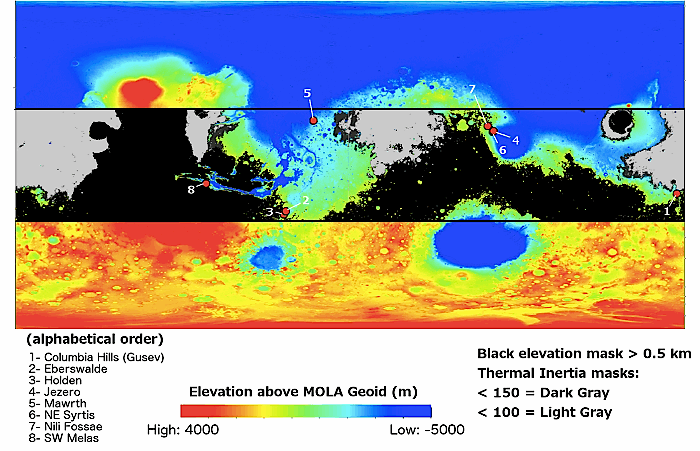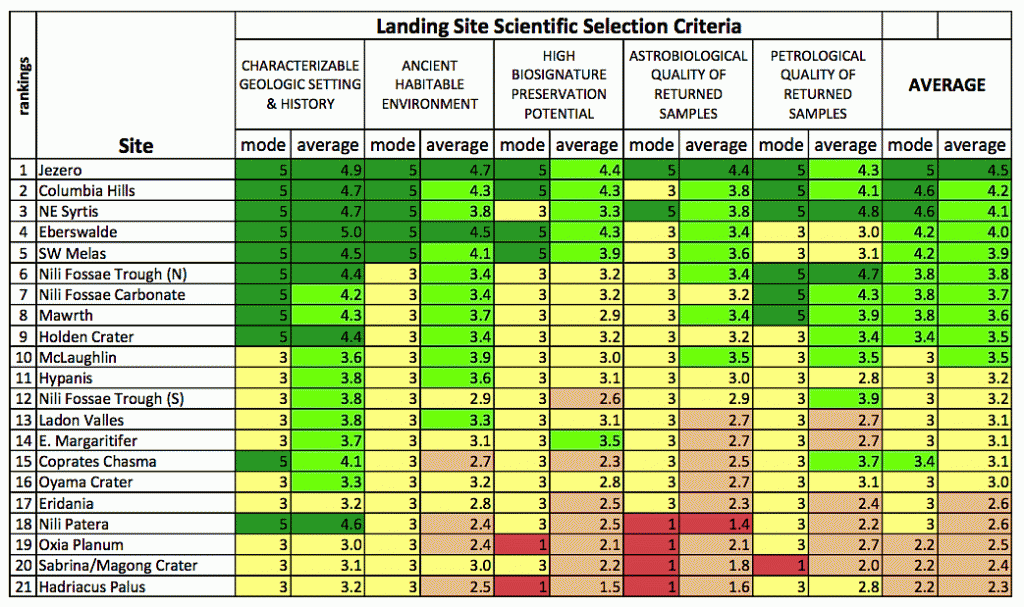 Designed to study rocks and soils to understand past habitable conditions on Mars and to seek signs of ancient microbial life, NASA’s Mars 2020 rover still has no formal name, but the work of selecting its landing site continues apace.
Designed to study rocks and soils to understand past habitable conditions on Mars and to seek signs of ancient microbial life, NASA’s Mars 2020 rover still has no formal name, but the work of selecting its landing site continues apace.
Scientists recently met for a second time to propose and evaluate potential landing sites. The second landing site workshop was held in Monrovia, California, August 4-6, 2015, with 150 to 200 scientists participating onsite and remotely. (The first workshop was in May 2014.)
The top 10 sites (out of 21 proposed) as ranked by the meeting participants on scientific grounds were: Jezero Crater (18.5°N, 77.4°E), Columbia Hills (Gusev Crater, 14.4°S, 175.6°E), NE Syrtis Major (17.8°N, 77.1°E), Eberswalde Crater (23.0°S, 327.0°E), SW Melas Basin (12.2°S, 290.0°E), Nili Fossae Trough North (21.0°N, 74.5°E), Nili Fossae Carbonate (21.9°N, 74.5°E), Mawrth Vallis (24.0°N, 341.1°E), Holden Crater (26.4°S, 325.1°E), and McLaughlin Crater (21.9°N, 337.8°E).
Most of these sites were proposed for the 2012 Mars Science Laboratory (Curiosity) mission, and one — the Columbia Hills of Gusev Crater — has been reconnoitered by the Mars Exploration Rover Spirit, which found hot-spring deposits there.
Along with science rankings, the Mars 2020 Rover Project also examined engineering, operations, and other factors. In addition, the project wished to reduce the number of candidate sites. When sifted through these filters, eight sites remained. In alphabetical order, they are: Columbia Hills/Gusev, Eberswalde, Holden, Jezero, Mawrth, NE Syrtis, Nili Fossae, and SW Melas. (In the final sorting, the Nili Fossae Carbonate site, which scored #7 on science, was deleted due to high engineering risk and science overlap with other sites. Holden moved up in its place.)
For the locations of the eight landing sites, see the Mars map above; for the rankings of all 21 sites according to their scientific criteria, see the chart below. Click either image to enlarge.
Mars 2020 is set for launch in July-August 2020, arriving in February 2021. The rover’s baseline mission will last one Mars year, or 1.9 Earth years. The engineering criteria for what makes a site feasible are here and the mission’s geological criteria and goals are here.









